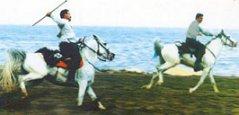Jereed (Cirit, Çavgan or Gokboru in Turkish) is a traditional sport of Turks played since centuries form the times of Turkic States. Horses were sacred and indispensable for Turks; they were born, grown up, fight, and die on the horse. They even drank Koumiss (kimiz) made of horses' milk.
The Javelin was the main game of Turks during ceremonies and considered to be the oldest of Turkish equestrian sports. It was first introduced to Anatolia in 1071 by the Seljuk ruler Alparslan. Jereed was played as a war game by the Ottomans after 16th century and became the biggest show game of the palace throughout the Ottoman Empire until 19th century. Being a dangerous sport as well, it was banned by the sultan Mahmud II in 1826, but after him was continued to be popular again and spread all over the country. Unfortunately in the last 25-30 years the game is limited only to the Eastern Anatolia, especially played during festivities or weddings in Erzurum, Erzincan, Bayburt, Kars and Sogut. Today apart from Turkey, the Jereed is also played in Iran, Afghanistan, Turkmenistan and other Asian countries were people of Turkish origin live.
 There are two opponent teams in a Jereed game, each formed by 6 or 8 or 12 players, standing on opposite sides of the field marked within a square of from 70 up to 130 meters (230-427 feet). There are three "end zones" at each end of the field, each about 6 meters deep, being a team's waiting area, thus meaning a neutral zone and the opposing team's throwing area. Each team has its own flag. The horses should be older than four years. A medium height horse is preferred because tall horses are not quick to maneuver, therefore most suitable ones are Arab and Turcoman horses.
There are two opponent teams in a Jereed game, each formed by 6 or 8 or 12 players, standing on opposite sides of the field marked within a square of from 70 up to 130 meters (230-427 feet). There are three "end zones" at each end of the field, each about 6 meters deep, being a team's waiting area, thus meaning a neutral zone and the opposing team's throwing area. Each team has its own flag. The horses should be older than four years. A medium height horse is preferred because tall horses are not quick to maneuver, therefore most suitable ones are Arab and Turcoman horses.
The Jereed game begins with introductions and handshakes at center field and a parade by each team with its flags. Then a military music of Janissaries and local music with drums and zurna's start. Riders test the field and their horses, then go back to their section. Jereed players in traditional regional costumes, a remembrance of the Sipahis (horseman) of the Janissaries, mount their local breed horses. With their right hand they hold the first jereed (a one meter-long, 2-3 centimeters in diameter, rubber-tipped stick of turned beech wood or poplar tree) that they'll throw while holding other jereeds in their left hand. One rider from one side rushes forth towards the opposite side getting as close as 30-40 meters and shouts the name of a player from the other team, swinging at him one of his sticks, challenging him to enter the game. Then he gallops back to his corner meanwhile the challenged player follows him and throws a jereed at the player who is running away. Another player from the first team comes out and meets the retreating rider. The player from the second team starts riding quickly to his side and takes his former place. This time his rival chases him and throws a jereed at him. The fast-charging chase game goes on like this. There are two 45-minute periods.
If a player manages to hit his rival with the stick, or outride him, or catch an incoming Cirit in mid-air then he wins points. Instead he will get negative points for actions that might endanger the horse; such as riding out of bounds or striking a horse intentionally, or falling off from his horse, or throwing the stick from inside the neutral zone, or throwing from closer than 5 meters during pursuit. Referees posted at the center line and at each end of the field award both positive and negative points with their flags.
The players make several different defensive maneuvers in order to avoid being hit by their opponents; he leans towards either side of the horse, under the horse's stomach or even its neck. Some players score more points by hitting his opponent three or four times before that player manages to escape and take his place back in his row. Cirit boys run across the field to retrieve errant throws and deliver them to both sides' "end zones". Even though today jereed tips are rounded rubber and light, sometimes players might be injured if they are hit on the head, eyes or ears. With today's sticks it's very rare but these injuries might even result in a death. If a player dies in the field, he's considered to have lost his life in battle as a martyr and his relatives don't sue against other player, except that a public case is opened by the court and a legal trial is done anyway. Therefore, if there are any known hostilities amongst players they can be left out of the tournament or put in the same team by the elder people of the village, or by the referees, before the game starts.
At the end of the game, the winner is announced by a council of former jereed players depending on points collected by two teams. Organizers give awards to the winning team and big meals are organized.

